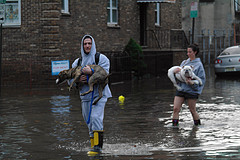
Hurricane Sandy flooding, October 2012
Today, the U.S. Government released its annual National Climate Assessment (NCA) and it is deservedly scary. Just last month, the United Nations released its landmark report on climate change, and it also was duly scary. Both of these reports, like the ones published before them, indicate that climate change is here, that it is largely caused by human activity such as burning of fossil fuels, that climate change is partly responsible for severe weather events like storms and drought, that climate change, if unchecked, will cause massive economic and other upheavals, and that climate change can be mitigated by lowering greenhouse gas emissions and using more clean renewable energy. However, many people seem to find climate change too big and too scary, and thus feel frozen to do anything about it. Instead of treating climate change as such a big scary problem, as these reports often do, perhaps it is now time to bite-size climate change in order to solve it.
Here’s what bite-sizing climate change could entail:
1. Regionalize — The NCA thankfully discusses climate change impact on each region of the U.S. For example, regarding the Northeast, the report states that:
Heat waves, heavy downpours, and sea level rise pose growing challenges to many aspects of life in the Northeast. Infrastructure, agriculture, fisheries, and ecosystems will be increasingly compromised.
In contrast, as to the Southwest, the report states:
Increased heat, drought, and insect outbreaks, all linked to climate change, have increased wildfires. Declining water supplies, reduced agricultural yields, health impacts in cities due to heat, and flooding and erosion in coastal areas are additional concerns.
Breaking the effects of climate change into regions is a good start. You can further localize climate change, for example, by discussing its effects with your friends, loved ones and colleagues where they live. Did one of them have a bridge wash out in their town due to flooding? How did that affect the businesses or commuters in the town? Knowing your audience is key to any effective communication. If you want to help others get a grasp on climate change and begin to seek to lessen its effects, you might at least want to start with the region where they live, and focus the climate change discussion on the disruption to their region’s way of life.
2. Industrialize — Climate change affects different businesses differently. Therefore, the one-size-fits-all scare tactic contained in many climate change reports may not be effective. Instead, we can try to think of particular businesses and industries hit by climate change, and perhaps use that business-based framework in our discussions. For example, farmers in California have been greatly affected by a years-long drought, which now covers 100 percent of California. Moreover, the snowpack in the Sierra Nevada Mountains, a crucial element in California’s water supply, was only at 18 percent of normal levels at the end of April, which means more water shortages are on the horizon for California farmers.
How about the ski industry? Climbing temperatures mean not only that ski areas may get less natural snow, they will have less days where it’s cold enough to make snow. If you know someone in the winter recreation industry (which includes not just ski areas but equipment makers, clothing companies, and local businesses such as hotels, shops and restaurants), that might make them shiver.
Indeed, as we wrote here in 2012, climate change presents many business opportunities, such as construction waterproofing and portable clean energy. There is potentially much money to be made in fighting climate change. Perhaps folks in the fossil fuel industry will recognize the commercial possibilities of green energy, and go from being climate deniers to climate doers. Thus, even Republicans have an interest in believing in the actual scientific evidence here.
3. Personalize — Do you buy fruit or vegetables? The aforementioned California drought will raise prices on a number of items you buy for your family at the supermarket, since California is a huge national supplier of produce such as lettuce, avocados, grapes and broccoli. That is just one example of how to personalize a huge scary problem such as global warming.
Do you live in coastal areas of states such as Florida? Do you own or are you planning to buy property on the coast? If so, rising sea levels as a result of climate change may make your investment worthless one day, as your home is constantly flooded. And it’s not just in Florida. Does anyone remember Superstorm Sandy? Good luck with your flood insurance in the future, if you’re a homeowner getting hit with more flooding due to climate change.
The examples outlined above just scratch the surface, and are intended merely as a starting point for discussion. No doubt you can think of many more examples in each of these categories, or even other categories in which to divide the climate change problem. The point is that, if you begin to think of global warming in more bite-sized terms, such as regional, industrial and personal, you can help get the conversation moving in a more manageable direction, and that may cause others to become unfrozen by this big scary problem and start to act to solve it.
Photo by Alec Perkins, used under Creative Commons license. http://is.gd/uWgBIx


